|

To supervise VENDETTA's background plates, Van and BFTR production manager Kerry Shea spent several intermittent days and weeks up on location in both Toronto and Kingston, Ontario, while BFTR producer Casey Cannon and coordinator Brent Coert held the fort in Los Angeles. All of the plates were shot as lockoffs to facilitate compositing with camera moves to be added digitally in post. To facilitate the primary matte work, Van had the art department build a series of inexpensive bluescreen flats that could be positioned and set up/held up at will to define crowd and action boundaries during the various live action plate shoots. A tight shoot schedule and the normal logistical challenges of shooting meticulous effects plates with hundreds of extras were compounded by the fact that all of the live action material was shot by cinematographer David Franco using a back net, which gave the film its characteristically gauzy, slightly halated look but also made pulling bluescreen mattes all the more difficult. As a result of this artistic choice and the use of film stocks that gave a grainy "period" look, almost all of the bluescreen shots had to be hand-rotoscoped using Puffin Designs' Commotion software.
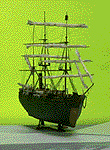
Model maker Jim Trois made three miniatures of vintage ships that might appear in New Orleans harbor in 1890. BFTR photographed the ships against a greenscreen in various angles with a still camera.
|

In Adobe Photoshop, BFTR artists painted a great deal of detail on the ships, producing several distinctive ship designs. Bluescreen-shot and computer generated extras were composited on the decks of these ships.
|
Although the various establishing shots of New Orleans were initially visualized by the production as "simple" still matte paintings in lockoffs, Van, lead digital artist Todd Vaziri and the other artists knew that they could bring to bear a whole range of techniques to add life and motion to the shots.
One of the first images in the film was a wide tilt/pan shot of a bustling New Orleans harbor featuring a great deal of foreground activity, with horse-drawn carts and laborers weaving in and around bales of cotton and piles of goods. The exterior plate was shot on the single dock of the Royal Military College next to Kingston's historic Fort Henry, where the bluescreen flats were used to back the dressed set. Since the entire top half of frame was not going to be used, Van had some of the extras placed on scaffolding behind and above the dressed set but in front of the bluescreen, in order to isolate a few extra bluescreen people, who could then be added to the decks of ships and to other shots without necessitating the shooting --and scanning costs-- of additional elements.
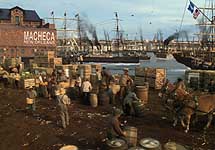
The final composite, complete with 2D animated birds, digital water and smoke elements, and several 2D matte paintings. Click here for a larger version of the shot, and download a Quicktime movie detailing the process of how this shot was completed: HI-REZ (4.1MB) or LOW-REZ (1.9MB). Requires Quicktime.
|
Once the difficult mattes were pulled/roto'd by Todd, 3D artist Gunther Schatz match-positioned a virtual camera and created a series of photorealistic water and wake elements using Alias and Arete software. Gunther also created and rendered the base element for the distant buildings on the far side of the river, which was then painted and augmented by artist Martha Soehendra and Van. The foreground buildings were created by Van using heavily-manipulated photos of the warehouse location, which was located in downtown Toronto, several hundred miles away from the port shoot location. The inclusion of these buildings --and some expository signage painted by artist Hitoshi Inoue-- helped to tie the two locations together.
In order to fill the harbor with appropriate ships and boats, BFTR enlisted modelmaker Jim Trois to build a number of detailed ship miniatures, including a tramp steamer, a sail/steam combination and a traditional riverboat. These relatively small models (created using available model kits as a base) were then photographed by Jim and Hitoshi against a greenscreen with a still camera in a variety of angles. The resultant images were put to PhotoCD and digitally manipulated in Adobe Photoshop by artists Hitoshi, Van, Martha and Alec Bartsch to make over a dozen individual ships with which to fill the harbor. To add more life and movement to the ships, Gunther generated a series of black smoke plumes and gently-waving flags in Alias|Wavefront's Maya.
Using Adobe After Effects, Van took all of these elements and composited them together in a complex series of animated layers, with bluescreen-shot actors on the decks of some of the ships, 2D animated birds, rocking boats, and additional plumes of smoke and churning wakes created directly in After Effects using Final Effects' powerful particle systems. Topping these off was the addition of a major pan/tilt camera move to the seven-second shot. �Take a look at a Quicktime movie that illustrates the various layers involved with this shot: HI-REZ (4.1MB) or LOW-REZ (1.9MB).
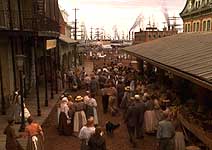
One of our three Decatur Street shots. Click here for a larger image, or download a Quicktime movie to see the layers of this shot: HI-REZ (3.3MB) or LOW-REZ (1.4MB).
|
The same techniques were used to create a series of wide shots looking down past the Italian marketplace on Decatur Street towards the waterfront. The challenge for these shots was that each was shot on a different shoot day under different lighting conditions with the camera semi-placed back in its original position, which meant that although the composition was roughly the same, all of the digital elements had to be adjusted between the various shots. In addition, BFTR was asked in post to "relight" one of the daytime shots into a magic-hour sunset shot, with the sun coming from entirely the opposite direction (in fact, the sky in this shot is actually created from a scan of one of Gunther's Hawaii vacation photos...). Numerous matte-painted buildings and a extensive dock extension, along with animated horse and buggy elements, completed the picture. Download a Quicktime movie to see the layers of one of our Decatur Street shots: HI-REZ (3.3MB) or LOW-REZ (1.4MB).
For the three Canal Street shots depicting Parkerson (Luke Askew) inciting the mob from the foot of the Henry Clay statue, Nick specifically wanted to recreate the composition and feel of an existing newspaper drawing of the actual event. The live plate was shot on a major street in Kingston, with the acceptably-period city hall on one side of the street and a not-so-usable morass of trees and modern tourist offices on the other. In order to replace the majority of the frame behind the sea of fist-waving extras, BFTR researched late 19th century architecture to create a detailed matte painting of the buildings along Canal Street. Gunther matched the camera angle in Alias and modeled a series of vintage buildings, with Van and Martha adding dozens of additional layers of detail to the textured and rendered base geometry. To add life to the painting, Todd then placed scores of bluescreen-shot extras (and some computer-generated ones) on the balconies and behind the windows of the digital buildings. Watch the shot being created: HI-REZ (4.1MB) or LOW-REZ (2.0MB).
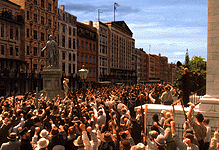
BFTR created a digital skyline for this shot of Canal Street. Click here for a larger image, or watch the shot being created: HI-REZ (4.1MB) or LOW-REZ (2.0MB).
|
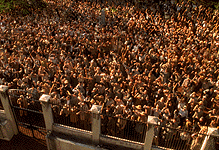
A crowd of a few dozen rioters becomes an angry mob of hundreds, through complex digital split screens. Watch the shot being created: HI-REZ (3.2MB) or LOW-REZ (1.4MB).
|
A prisoner's high-angle window view of the sea of angry lynchers outside the prison was done using classic crowd-replication techniques: With a locked-off camera, a group of some 80 to 100 extras was photographed in six separate passes, each with the group in different locations in frame; bluescreen flats were carefully placed behind or alongside the group in each pass to help in the matting process. The half-dozen plates (and a clean plate) were then scanned and combined digitally to create the illusion of several hundred people. Unfortunately, even though the passes were shot within minutes of each other, the weather changed drastically between takes: in one pass, the sun is blazing through, creating harsh shadows; in another, the skies were completely overcast; and in others, the accelerating late afternoon sun cast longer and longer shadows. Hitoshi had to perform a great deal of shadow-matting and color correction to make all of the elements match in a single composite. Watch the shot being built: HI-REZ (3.2MB) or LOW-REZ (1.4MB). continued...


Banned From The Ranch Entertainment Home Page
����General Information: info@bftr.com
|

